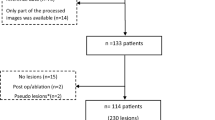Abstract
Purpose
To differentiate proxy renal cystic lesions containing protein, blood, iodine contrast or saline solutions using dual-energy CT (DECT) equipped with a new tin filter technology (TFT).
Materials and methods
70 proxies (saline, protein, blood and contrast agent) were placed in unenhanced and contrast-enhanced kidney phantoms. DECT was performed at 80/140 kV with and without tin filtering. Two readers measured the CT attenuation values in all proxies twice. An 80/140 kV ratio was calculated.
Results
All intra- and interobserver agreements were excellent (r = 0.93–0.97; p < 0.001). All CT attenuation values were significantly higher in the enhanced than in the unenhanced setting (p < 0.05; average increase, 12.5 ± 3.6HU), while the ratios remained similar (each, p > 0.05). The CT attenuation of protein, blood and contrast agent solution differed significantly with tin filtering (p < 0.01–0.05). Significant differences were found between the ratios of protein and blood compared to contrast medium solution (each, p < 0.05) and between the ratios of protein and blood in both phantoms with tin filtering (each, p < 0.05).
Conclusion
DECT allows discrimination between a proxy renal lesion containing contrast agent and lesions containing protein and blood through their different attenuation at 80 kV and 140 kV. Further discrimination between protein and blood containing proxies is possible when using a tin filter.


Similar content being viewed by others
References
Tada S, Yamagishi J, Kobayashi H, Hata Y, Kobari T (1983) The incidence of simple renal cyst by computed tomography. Clin Radiol 34:437–439
Bosniak MA (1986) The current radiological approach to renal cysts. Radiology 158:1–10
Bosniak MA (1991) The small (less than or equal to 3.0 cm) renal parenchymal tumor: detection, diagnosis, and controversies. Radiology 179:307–317
Israel GM, Bosniak MA (2005) How I do it: evaluating renal masses. Radiology 236:441–450
Jonisch AI, Rubinowitz AN, Mutalik PG, Israel GM (2007) Can high-attenuation renal cysts be differentiated from renal cell carcinoma at unenhanced CT? Radiology 243:445–450
Silverman SG, Mortele KJ, Tuncali K, Jinzaki M, Cibas ES (2007) Hyperattenuating renal masses: etiologies, pathogenesis, and imaging evaluation. Radiographics 27:1131–1143
Silverman SG, Israel GM, Herts BR, Richie JP (2008) Management of the incidental renal mass. Radiology 249:16–31
Millner MR, McDavid WD, Waggener RG, Dennis MJ, Payne WH, Sank VJ (1979) Extraction of information from CT scans at different energies. Med Phys 6:70–71
Chandarana H, Godoy MC, Vlahos I et al (2008) Abdominal aorta: evaluation with dual-source dual-energy multidetector CT after endovascular repair of aneurysms—initial observations. Radiology 249:692–700
Scheffel H, Stolzmann P, Frauenfelder T et al (2007) Dual-energy contrast-enhanced computed tomography for the detection of urinary stone disease. Invest Radiol 42:823–829
Stolzmann P, Frauenfelder T, Pfammatter T et al (2008) Endoleaks after endovascular abdominal aortic aneurysm repair: detection with dual-energy dual-source CT. Radiology 249:682–691
Chae EJ, Song JW, Seo JB, Krauss B, Jang YM, Song KS (2008) Clinical utility of dual-energy CT in the evaluation of solitary pulmonary nodules: initial experience. Radiology 249:671–681
Fletcher JG, Takahashi N, Hartman R et al (2009) Dual-energy and dual-source CT: is there a role in the abdomen and pelvis? Radiol Clin North Am 47:41–57
Graser A, Johnson TR, Chandarana H, Macari M (2009) Dual energy CT: preliminary observations and potential clinical applications in the abdomen. Eur Radiol 19:13–23
Stolzmann P, Scheffel H, Rentsch K et al (2008) Dual-energy computed tomography for the differentiation of uric acid stones: ex vivo performance evaluation. Urol Res 36:133–138
Stolzmann P, Kozomara M, Chuck N et al (2009) In vivo identification of uric acid stones with dual-energy CT: diagnostic performance evaluation in patients. Abdominal imaging. doi:10.1007/s00261-009-9569-9
Primak AN, Ramirez Giraldo JC, Liu X, Yu L, McCollough CH (2009) Improved dual-energy material discrimination for dual-source CT by means of additional spectral filtration. Med Phys 36:1359–1369
Chae EJ, Seo JB, Goo HW et al (2008) Xenon ventilation CT with a dual-energy technique of dual-source CT: initial experience. Radiology 248:615–624
Ferda J, Ferdova E, Mirka H et al (2009) Pulmonary imaging using dual-energy CT, a role of the assessment of iodine and air distribution. European Journal of Radiology. doi:10.1016/j.ejrad.2009.08.005
Thieme SF, Johnson TR, Lee C et al (2009) Dual-energy CT for the assessment of contrast material distribution in the pulmonary parenchyma. AJR 193:144–149
Stolzmann P, Leschka S, Scheffel H et al (2010) Characterization of urinary stones with dual-energy CT: improved differentiation using a tin filter. Invest Radiol 45:1–6
Thomas C, Krauss B, Ketelsen D et al (2010) Differentiation of urinary calculi with dual energy CT: effect of spectral shaping by high energy tin filtration. Invest Radiol 45:393–398
Leschka S, Stolzmann P, Baumuller S et al (2010) Performance of dual-energy CT with tin filter technology for the discrimination of renal cysts and enhancing masses. Acad Radiol 17:526–534
Graser A, Becker CR, Staehler M et al (2010) Single-phase dual-energy CT allows for characterization of renal masses as benign or malignant. Invest Radiol 45:399–405
Tsuda K, Kinouchi T, Tanikawa G et al (2005) Imaging characteristics of papillary renal cell carcinoma by computed tomography scan and magnetic resonance imaging. Int J Urol 12:795–800
Brown CL, Hartman RP, Dzyubak OP et al (2009) Dual-energy CT iodine overlay technique for characterization of renal masses as cyst or solid: a phantom feasibility study. Eur Radiol 19:1289–1295
Author information
Authors and Affiliations
Corresponding author
Rights and permissions
About this article
Cite this article
Karlo, C., Lauber, A., Götti, R.P. et al. Dual-energy CT with tin filter technology for the discrimination of renal lesion proxies containing blood, protein, and contrast-agent. An experimental phantom study. Eur Radiol 21, 385–392 (2011). https://doi.org/10.1007/s00330-010-1926-0
Received:
Revised:
Accepted:
Published:
Issue Date:
DOI: https://doi.org/10.1007/s00330-010-1926-0




